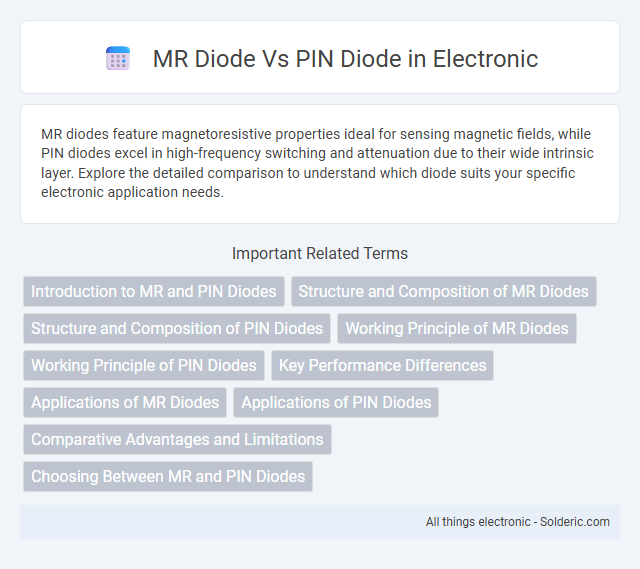MR diodes feature magnetoresistive properties ideal for sensing magnetic fields, while PIN diodes excel in high-frequency switching and attenuation due to their wide intrinsic layer. Explore the detailed comparison to understand which diode suits your specific electronic application needs.
Comparison Table
| Feature | MR Diode | PIN Diode |
|---|---|---|
| Full Name | Magnetoresistive Diode | PIN (P-type, Intrinsic, N-type) Diode |
| Structure | Thin film with magnetic layers | Three-layer semiconductor (P, Intrinsic, N) |
| Primary Use | Magnetic field sensing, memory devices | High-frequency RF switching, attenuation, and detection |
| Frequency Response | Limited to magnetic sensors applications | Wide frequency range, up to GHz |
| Switching Speed | Relatively slow due to magnetic domain dynamics | Fast switching suitable for RF circuits |
| Power Handling | Low power applications | High power RF applications |
| Capacitance | Dependent on magnetic layer properties | Low junction capacitance for high-frequency use |
| Cost & Availability | Specialized, less common | Widely available, cost-effective |
| Typical Applications | Magnetoresistive sensors, MRAM | RF attenuators, switches, detectors |
Introduction to MR and PIN Diodes
MR diodes are magnetoresistive devices primarily used for sensing magnetic fields, exploiting changes in resistance based on magnetic influence, whereas PIN diodes are semiconductor devices with an intrinsic layer between the p-type and n-type regions, designed for high-frequency switching and attenuation applications. Your choice depends on whether magnetic sensitivity or RF performance is required, as MR diodes are optimized for magnetic detection and PIN diodes excel in signal modulation and power control. Understanding these fundamental differences guides effective implementation in electronics and communication systems.
Structure and Composition of MR Diodes
MR diodes feature a metal-rich semiconductor layer that enhances their minority carrier injection efficiency, distinguishing them from the intrinsic layer found in PIN diodes. The structure of MR diodes typically involves a metal-semiconductor junction combined with a lightly doped region, optimizing switching speed and reducing capacitance. Your choice between MR and PIN diodes should consider the specific application requirements for high-frequency performance and signal integrity.
Structure and Composition of PIN Diodes
PIN diodes feature a layered structure consisting of an intrinsic (undoped) semiconductor region sandwiched between p-type and n-type layers, which enhances their ability to operate at high frequencies and control RF signals efficiently. Unlike MR diodes, PIN diodes rely on this intrinsic layer to improve charge storage and reduce capacitance, making them ideal for fast switching and low-distortion applications. Your choice between MR and PIN diodes should consider how the intrinsic layer's properties impact performance in your specific high-frequency or signal modulation needs.
Working Principle of MR Diodes
MR diodes operate based on magnetoresistance effects, where an applied magnetic field causes a change in electrical resistance by influencing electron spin alignment within magnetic materials. Unlike PIN diodes that rely on the injection and recombination of charge carriers in intrinsic regions, MR diodes manipulate spin-dependent electron transport, enabling sensitive magnetic field detection. Your choice between MR and PIN diodes depends on application needs, especially when precise magnetic sensing is required.
Working Principle of PIN Diodes
PIN diodes function by utilizing an intrinsic semiconductor layer sandwiched between p-type and n-type layers, creating a wide depletion region that modulates electrical conductivity based on applied voltage. This unique structure enables PIN diodes to act as variable resistors at RF and microwave frequencies, making them essential components in switches, attenuators, and phase shifters. In contrast, MR diodes typically rely on magnetic resistance effects, differing fundamentally from the charge carrier modulation principle governing PIN diode operation.
Key Performance Differences
MR diodes exhibit higher sensitivity and faster switching speeds compared to PIN diodes, making them ideal for high-frequency applications. PIN diodes offer better power handling and lower insertion loss, which is crucial in RF and microwave circuits. Your choice depends on whether speed or power efficiency is the priority in your electronic design.
Applications of MR Diodes
MR diodes, or Metal-Rich diodes, excel in high-frequency and microwave switching applications due to their fast switching speeds and low capacitance. These diodes are widely used in radar systems, communication devices, and signal modulation, where precision and reliability are critical. Your choice of an MR diode ensures enhanced performance in RF circuits compared to PIN diodes, which are often preferred for power handling and variable attenuation tasks.
Applications of PIN Diodes
PIN diodes are widely used in RF and microwave applications such as attenuators, switches, and phase shifters due to their ability to handle high-frequency signals with low distortion. Their intrinsic layer allows for fast switching and high power handling, making them essential in communication systems, radar, and signal modulation. Understanding your application's frequency and power requirements helps determine the suitability of PIN diodes compared to MR diodes.
Comparative Advantages and Limitations
MR diodes offer faster switching speeds and lower capacitance, making them ideal for high-frequency and microwave applications, while PIN diodes provide higher power handling capability and better linearity, suitable for RF switching and attenuator circuits. Your choice depends on the application requirements, where MR diodes excel in speed-sensitive tasks and PIN diodes deliver superior performance in power management and signal modulation. Limitations include MR diodes' lower power tolerance compared to PIN diodes, which may restrict their use in high-power scenarios.
Choosing Between MR and PIN Diodes
Choosing between MR (Metal-Semiconductor-Metal) diodes and PIN (Positive-Intrinsic-Negative) diodes depends on the application frequency and switching requirements. MR diodes excel in high-speed switching and low capacitance, making them ideal for microwave and millimeter-wave circuits. PIN diodes are preferred for RF switching and attenuators due to their higher power handling and linearity across a broad frequency range.
MR diode vs PIN diode Infographic

 solderic.com
solderic.com